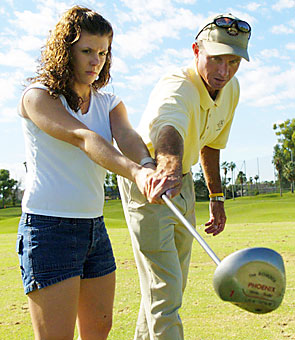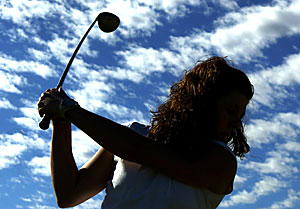 |
|
SAUL LOEB/Arizona Daily Wildcat
|
Randolph Golf Course professional and PE 219 instructor William Kane teaches entrepreneurship and marketing senior Illisa Larimore proper backswing technique yesterday at Randolph Golf Course.
|
|
|
By Brett Fera
Arizona Daily Wildcat
Thursday, September 30, 2004
Print this
Editor's note: This is the second part of the Wildcat's series examining the relationship between athletics and academics at the UA.
If it's said that most big business deals happen on the golf course, then the PGA and the UA's Eller College must have been listening.
"I could sit across from you in a desk and tell you, 'I'm selling 300 of these,' and we're indoors wearing suits with stale coffee and the whole deal," said William Kane, a 1987 UA graduate and head professional at Randolph Golf Course. "But if I tell you, 'Hey, let's go out and play La Paloma (Resort and Spa) and that it's on me, and we're out having a good time, somewhere, out on the fifth hole, that 300 is going to change."
A similar idea was the basis of the "Golf: For Business and Life" program of college classes, a creation of the Professional Golf Association of America that gives universities nationwide the ability help students learn how a day in the sun with a five iron in hand has the potential be a greater business tool than any indoor meeting with pie charts and bar graphs could ever be.
Kane, a former Wildcat who played on the UA golf team in the early to mid-80s, teaches the course, offered to upper-division business majors at the UA, as a joint venture between the physical education department and the Eller College of Management as PE 219.
Alongside assistants Robby Watson and Pete Federhar, a 2002 UA graduate, Kane instructs three separate sections of the course. Each meet twice a week for an hour and 40 minutes at Randolph Golf Course, 600 S. Alvernon Way.
Accounting senior Svetlana Pitman said while using the golf course as an office could be a successful way to market her ideas once she graduates, the ability to get out of the classroom was enticing enough to sign up.
"You're outside, you're learning something, and it has nothing to do with your major," said Pitman. "When you have 15 units and nine of them are accounting classes and all you do is look at the books, it's nice to go outside and get out of the classroom."
The Professional Golf Association of America began the program five years ago, after PGA players selected for the 1999 Ryder Cup - a tournament pitting the top players from United States against Europe's best - wanted to be compensated in some capacity for their efforts.
The result: an agreement between the PGA and its pros to donate a lump sum of money to a charity in the player's name.
The plan led former UA golfer and U.S Open champion Jim Furyk to donate his share to the UA when he made the 2001 Ryder Cup team, and ultimately led to donations this year in the name of 12 Ryder Cup members, including Stanford alum Tiger Woods and former Arizona State star Phil Mickelson.
The UA received a cut of $100,000 just a couple of weeks ago in Furyk's name, Kane said, with the sole purpose to be used on the PE 219 course. The money goes toward paying the instructors, equipment and usage fees at Randolph Golf Course and administrative fees, Kane said.
While he admits that the final probably can't compete with nuclear physics, Kane said that he operates the class like any other on the UA campus, complete with exams and daily attendance policies.
Kane said he hopes to see the course stay on the schedule of classes, even though that thought puts even more pressure on Furyk, or any other former UA golfer playing on the PGA tour, for that matter.
"As long as Jim keeps making the Ryder Cup, we'll still have the golf for business and life class," Kane said.
 |
|
SAUL LOEB/Arizona Daily Wildcat
|
Entrepreneurship and marketing senior Illisa Larimore reaches the peak of her backswing during yesterday's PE 219 class at Randolph Golf Course. The class is geared toward teaching business majors the value of using golf as a business tool.
|
|
|
For Pittman and her classmates, the coursework is both entertaining and informative, although it's anything but easy.
"It's harder than I thought it was going to be," said accounting senior Christina Elzy. "I can hit a pretty good shot. Not consistently, but I can hit it."
Giorgios Sotiriou, a philosophy and economics senior, was one of the few non-Eller students to slip through the cracks and make it into the course.
"By the time we're done I just hope I don't look stupid," Sotiriou said.
"You know, you hit a good shot and you think, 'Oh life is great,'" Pitman added. "Then you hit 20 more shots before you hit that same one again."
Sixteen students arrive at the range at 8 a.m. every Tuesday and Thursday, while another group shows up for class at 4 p.m. on the same days. The third section is offered Monday and Wednesday at 8 a.m.
The 8 a.m. opening doesn't phase anyone, though. Pitman said early morning start times are the norm for the Eller College, not to mention out in the business world.
"Let's see, you have a choice to be at Eller at 8 a.m. reading financial statements or you can be at the golf course listening how to swing properly so the ball can go 200 yards," Pitman said.
"No sweat the choice," Elzy added.
Kane said with the regular if not often occurrence of corporate tournaments, his goal is to take those students with less skill on the course and eliminate their fear of using it to their advantage.
"We'll sit the first day and I'll say, 'Look, if you're a scratch golfer ready for the golf team, this probably isn't for you," Kane said, adding that about 16 students are enrolled in each section. "We're tailoring this class, the whole premise - you're about to graduate and go into the business world and there are huge opportunities in corporate America to advance your career and advance your business playing golf."
Kane said the atmosphere of the class, coupled with the basic instruction and confidence building drills he and his staff does each day, leads to his students learning how step up when its their turn to put the ball in the hole.
"You might never meet the CEO," Kane said, "but if you're paired with him on the golf course and you make a 20-foot putt on the last hole to win the tournament, he'll know your name."
